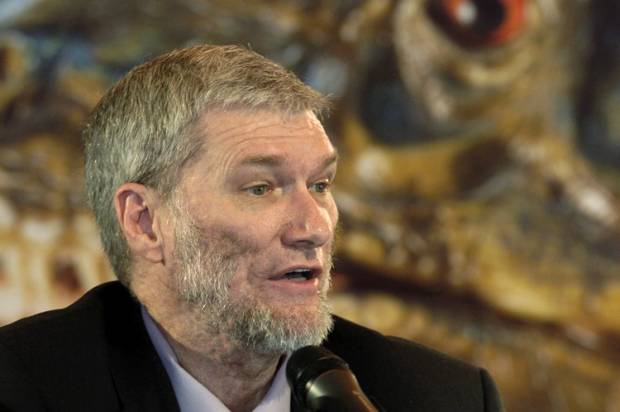Wednesday, July 30, 2014
u.s. network infrastructure under attack: subversion of future time orientation failure?
By
CNu
at
July 30, 2014
0
comments
![]()
Labels: Collapse Crime , de-evolution , domestic terrorism , institutional deconstruction
Tuesday, July 29, 2014
who goes dry first, vegas or phoenix?
By
CNu
at
July 29, 2014
15
comments
![]()
Labels: weather report , What Now?
satellite study reveals parched u.s. west using up underground water
This study is the first to quantify the amount that groundwater contributes to the water needs of western states. According to the U.S. Bureau of Reclamation, the federal water management agency, the basin has been suffering from prolonged, severe drought since 2000 and has experienced the driest 14-year period in the last hundred years. The study has been accepted for publication in Geophysical Research Letters, a journal of the American Geophysical Union, which posted the manuscript online today.
The research team, led by NASA and University of California, Irvine, scientists, used data from NASA’s Gravity Recovery and Climate Experiment (GRACE) satellite mission to track changes in the mass of the Colorado River Basin, which are related to changes in water amount on and below the surface. Monthly measurements of the change in water mass from December 2004 to November 2013 revealed the basin lost nearly 53 million acre feet (65 cubic kilometers) of freshwater, almost double the volume of the nation’s largest reservoir, Nevada’s Lake Mead. More than three-quarters of the total — about 41 million acre feet (50 cubic kilometers) — was from groundwater.
“We don’t know exactly how much groundwater we have left, so we don’t know when we’re going to run out,” said Stephanie Castle, a water resources specialist at the University of California, Irvine, and the study’s lead author. “This is a lot of water to lose. We thought that the picture could be pretty bad, but this was shocking.”
Water above ground in the basin’s rivers and lakes is managed by the U.S. Bureau of Reclamation, and its losses are documented. Pumping from underground aquifers is regulated by individual states and is often not well documented.
“There’s only one way to put together a very large-area study like this, and that is with satellites,” said senior author Jay Famiglietti, senior water cycle scientist at NASA’s Jet Propulsion Laboratory (JPL) in Pasadena, California, on leave from UC Irvine, where he is an Earth system science professor. “There’s just not enough information available from well data to put together a consistent, basin-wide picture.”
Famiglietti said GRACE is like having a giant scale in the sky. Within a given region, the change in mass due to rising or falling water reserves influences the strength of the local gravitational attraction. By periodically measuring gravity regionally, GRACE reveals how much a region’s water storage changes over time.
The Colorado River is the only major river in the southwestern United States. Its basin supplies water to about 40 million people in seven states, as well as irrigating roughly four million acres of farmland. Fist tap Dale.
By
CNu
at
July 29, 2014
0
comments
![]()
Labels: weather report , What Now?
Monday, July 28, 2014
the government rulebook for labelling you a "terrorist"
By
CNu
at
July 28, 2014
48
comments
![]()
Labels: agenda , civil war , clampdown , elite , establishment
Sunday, July 27, 2014
thirsty in the detroit littoral: writing off the future of a large part of humanity...,
By
CNu
at
July 27, 2014
14
comments
![]()
Labels: clampdown , Collapse Casualties , Collapse Crime , What Now?
doing god's work reducing surplus population
Trevelyan's most enduring mark on history may be the quasi-genocidal anti-Irish racial sentiment [sic] he expressed during his term in the critical position of administrating relief for the millions of Irish peasants suffering under the Irish famine as Assistant Secretary to HM Treasury (1840-1859) under the Whig administration of Lord Russell.[1]
His most lasting contribution, however, began in the 1850s with the publication of his and Sir Stafford Northcote's report on 'The Organisation of the Permanent Civil Service'. The report led to the transformation of the civil service. Educational standards and competitive admission examinations ensured that a more qualified body of civil servants would become administrators.[2]
By
CNu
at
July 27, 2014
0
comments
![]()
Labels: agenda , cull-tech , elite , establishment
the biology of ideology
By
CNu
at
July 27, 2014
0
comments
![]()
Labels: essence , neurotypes , What IT DO Shawty...
mistreatment effects gene expression
By
CNu
at
July 27, 2014
0
comments
![]()
Labels: Genetic Omni Determinism GOD
Saturday, July 26, 2014
how far should society go to make sure "the least of these" get the best available treatments?
By
CNu
at
July 26, 2014
60
comments
![]()
Labels: profitability , ROI , scarcity , scientific morality
the christian right's five worst "scientific" claims
Secularists are desperate to find life in outer space, as they believe that would provide evidence that life can evolve in different locations and given the supposed right conditions! The search for extraterrestrial life is really driven by man’s rebellion against God in a desperate attempt to supposedly prove evolution!
By
CNu
at
July 26, 2014
7
comments
![]()
Labels: the wattles
the runner-up religions of america
By
CNu
at
July 26, 2014
0
comments
![]()
Labels: American Original
Friday, July 25, 2014
tossing bd an expensive prr bone: current opinion in neurobiology communication and language issue
sciencedirect | Communication and language - Edited by Michael Brainard and Tecumseh Fitch
Communication about social status
Review Article- Pages 1-4
- Russell D Fernald
- Not entitled to full text
The evolution of language from social cognition
Review Article- Pages 5-9
- Robert M Seyfarth, Dorothy L Cheney
Highlights
- Language and primate communication share many neural mechanisms and social functions.
- Like humans, primates use vocalizations to facilitate social interactions
- Call meaning depends on call type, caller ID, kinship, rank, and prior behavior.
- Primate communication constitutes a discrete, combinatorial, and open-ended system.
- When language first evolved, many of its distinctive features were already present.
By
CNu
at
July 25, 2014
6
comments
![]()
Labels: big don special
citing drudge, big don says that dogs and chimps have language...,
By
CNu
at
July 25, 2014
0
comments
![]()
Labels: big don special , ethology
dogs feel jealousy
By
CNu
at
July 25, 2014
0
comments
![]()
Labels: ethology
Thursday, July 24, 2014
how america changed the meaning of war
By
CNu
at
July 24, 2014
24
comments
![]()
Labels: Living Memory , resource war , unspeakable , What Now?
somewhere in new mexico before the end of time...,
Here some of the premiere thinkers often referred to as "doomers" talk about climate change and the impacts of an industrial system on earth systems. Is it already too late?
By
CNu
at
July 24, 2014
0
comments
![]()
Labels: Collapse Casualties , Peak Capitalism
the right to exclude others (property rights) is the foundational american religious principle
By
CNu
at
July 24, 2014
0
comments
![]()
Labels: austerity , Collapse Casualties
Wednesday, July 23, 2014
never mind the rhetoric - the property "right" is the might to exclude others...,
The conquest of Gaza is accelerating. Israel has now launched its ground invasion, bringing the Palestinian death toll to 260, 80% of whom are civilians.
A further 1,500 have been wounded and 1,300 Palestinian homes destroyed. Israel's goal, purportedly, is to "restore quiet" by ending Hamas rocket attacks on Israel.
Last Tuesday, Israeli defence minister and former Israeli Defence Force (IDF) chief of staff Moshe Ya'alon announced that Operation Protective Edge marks the beginning of a protracted assault on Hamas.
The operation "won't end in just a few days", he said, adding that "we are preparing to expand the operation by all means standing at our disposal so as to continue striking Hamas."
The price will be very heavy ... yes, $4 billion!
The following morning, he went on: "We continue with strikes that draw a very heavy price from Hamas. We are destroying weapons, terror infrastructures, command and control systems, Hamas institutions, regime buildings, the houses of terrorists, and killing terrorists of various ranks of command ...
"The campaign against Hamas will expand in the coming days, and the price the organization will pay will be very heavy."
But in 2007, a year before Operation Cast Lead, Ya'alon's concerns focused on the 1.4 trillion cubic feet of natural gas discovered in 2000 off the Gaza coast, valued at $4 billion.
By
CNu
at
July 23, 2014
1 comments
![]()
Labels: killer-ape , resource war , The Hardline
children exposed to religion have difficulty distinguishing fact from fiction...,
By
CNu
at
July 23, 2014
18
comments
![]()
Labels: the wattles , theoconservatism , What IT DO Shawty...
Nassim Taleb: Two Myths About Rivalry, Scarcity, Competition, and Cooperation
By
CNu
at
July 23, 2014
0
comments
![]()
Labels: as above-so below , chess-not checkers , The Hardline
Trash Israeli Professional Boxer Spitting On And Beating On Kids At UCLA...,
sportspolitika | On Sunday, however, the mood turned ugly when thousands of demonstrators, including students and non-students, showed ...

-
theatlantic | The Ku Klux Klan, Ronald Reagan, and, for most of its history, the NRA all worked to control guns. The Founding Fathers...
-
Video - John Marco Allegro in an interview with Van Kooten & De Bie. TSMATC | Describing the growth of the mushroom ( boletos), P...
-
Farmer Scrub | We've just completed one full year of weighing and recording everything we harvest from the yard. I've uploaded a s...











